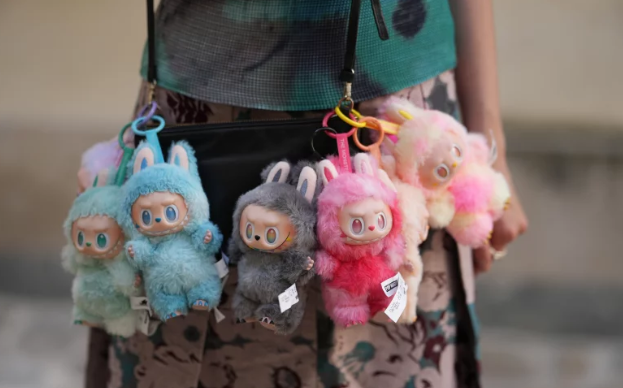Once a whimsical character in a children’s book, Labubu, the mischievous, elf-like doll with rabbit ears and sharp little teeth, has exploded into a billion-dollar collectible craze, captivating pop stars, fashion icons, and everyday enthusiasts alike.
THE BIRTH OF LABUBU
Labubu is the brainchild of Hong Kong-born artist Kasing Lung, an illustrator known for his whimsical creations.
In 2015, Lung created Labubu, along with its companions like Zimomo, Spooky, and Tycoco, as part of the characters for his children’s book series ‘The Monsters’. Labubu’s character features a mischievous grin, rabbit‑like ears, and sharp little teeth that were inspired by Nordic folklore.
Labubu took physical form in 2019 when Chinese toy giant Pop Mart partnered with Lung to produce a line of collectible blind‑box figurines of the series. The character-based product company revolutionized the toy market by packaging figures in opaque boxes so the buyer doesn’t know which specific design they’ll get until they open it. The element of surprise and the thrill of the chase for rare “secret” editions fueled an addictive collecting frenzy.
The first Labubu keychain series, called ‘Exciting Macaron’, was released in October 2023. Other collections include ‘Fall in Wild’, the seven-figurine ‘Have a Seat’ line, and ‘Big into Energy’.
The doll has been depicted as a magician, a diver, an astronaut, and countless other personas, each maintaining the character’s core identity while offering novelty. This wide variety encourages collectors to complete series and eagerly anticipate new releases.
WHY IS LABUBU SO POPULAR?
Celebrity endorsements supercharged Labubu’s meteoric rise. In April 2024, BLACKPINK’s Lisa casually showed off a Labubu keychain on her Instagram, igniting a shopping frenzy across Asia. The organic endorsement sparked what Teen Vogue and Vogue Italia described as the “first wave of fame” for the doll.
Soon after, global stars like Rihanna and Dua Lipa were spotted with Labubu dolls dangling from their designer bags, including appearances at Paris Fashion Week. Even David Beckham jumped into the trend, showcasing Labubu in public outings.
Photo credit: KUA CHEE SIONG
In May 2025, Indian actress Ananya Panday’s pastel-pink Labubu went viral, prompting beauty brand Lakmé to launch a Labubu-themed campaign. K-pop idols from SEVENTEEN and other groups further amplified the hype, posting customized Labubus online. Demand grew so intense that Pop Mart temporarily suspended in-store sales in South Korea due to safety concerns.
THE COST OF LABUBU
Adults, especially young women, have begun treating Labubu as a collectible accessory: bag charms, car ornaments, and fashion accessories. Miniature couture versions appeared at events in Indonesia and Paris, where designers like Sebastian Gunawan created outfits tailored for tiny Labubus.
Pop Mart also extended its collaborations, releasing limited editions with Coca‑Cola, One Piece, and luxury brands like Louis Vuitton in exclusive blind‑box runs at places like the Louvre. These collaborations often result in limited-edition, highly coveted items, further driving up demand and perceived value.
Prices reflected the craze. By 2025, Pop Mart had released over 300 different Labubu figurines, ranging in size and price. Standard Labubus retail around $15–$30; rare “secret” variants often sell for over $1,000. This month, a four-foot-tall mint-green Labubu was sold for $170,000 at the first official Labubu auction held in Beijing.
As the brand’s popularity continues to soar, counterfeit versions — known as ‘Lafufus’ — have begun circulating in the market. Fake accessories have also surfaced online, attracting a surprising level of interest from some collectors drawn to their offbeat designs.
According to Pop Mart’s report released on August 20, 2024, the product line raked in 6.3 billion Chinese yuan (about $870 million) in sales within just the first half of the year.
CONTROVERSY AND CRITICISM
Despite its success, Labubu’s blind-box model has faced backlash. Critics compare it to gambling, as the randomised nature fuels compulsive buying, especially among young fans. In response, Chinese regulators imposed restrictions, banning sales to children under eight and mandating clearer odds disclosure. Consumer advocates continue pushing for stricter corporate accountability, warning of the psychological risks tied to collectible obsessions. The federation council in Russia also proposed banning the sale of Labubus due to the “frightening appearance” and potential harm to children’s mental health.
WHAT NEXT?
As Labubu’s popularity shows no signs of slowing, Pop Mart teases even more ambitious projects — from augmented-reality collectibles to animated series. Whether as a fashion statement, investment, or cultural icon, Labubu has cemented its place in the global toy hall of fame, proving that sometimes, the weirdest little creatures make the biggest impact.
Copyright 2025 TheCable. All rights reserved. This material, and other digital content on this website, may not be reproduced, published, broadcast, rewritten or redistributed in whole or in part without prior express written permission from TheCable.
Follow us on twitter @Thecablestyle


